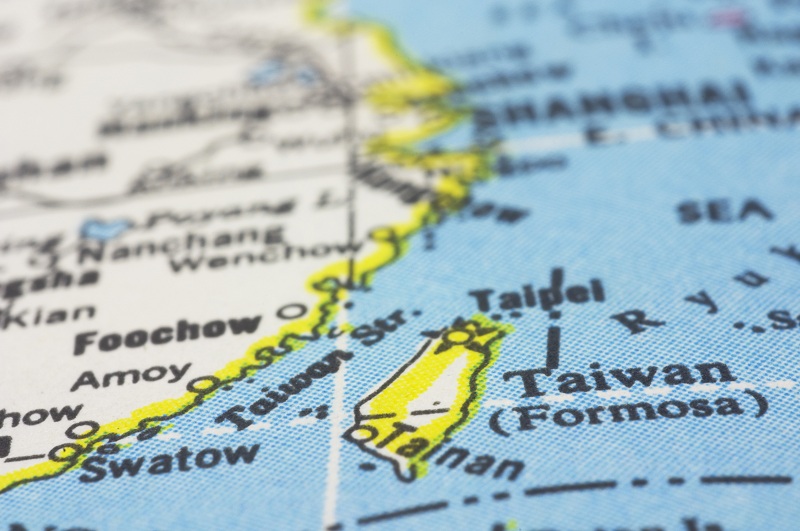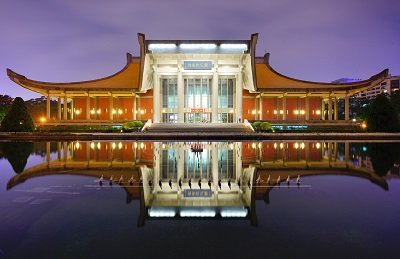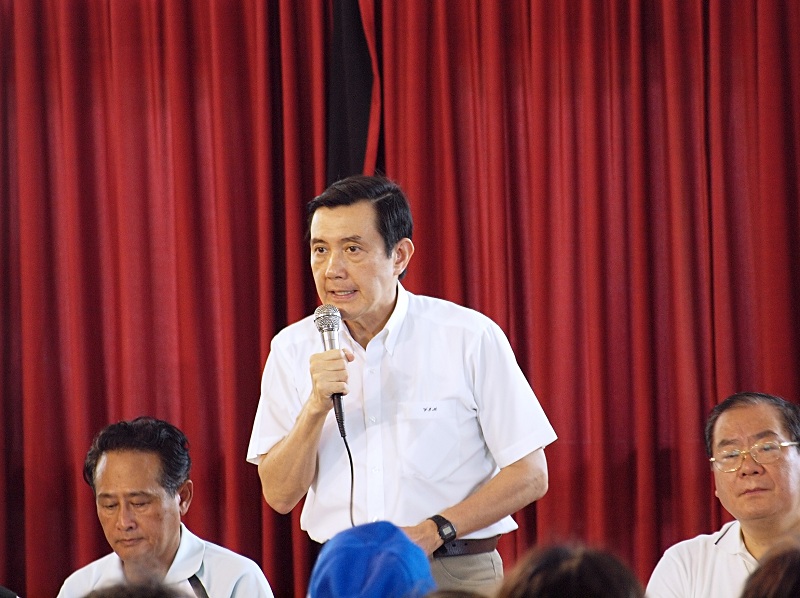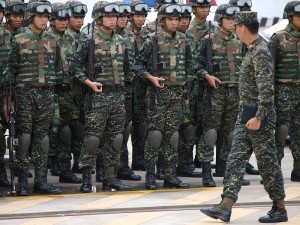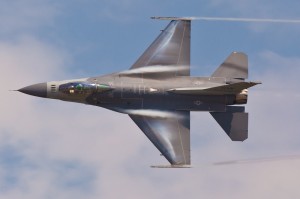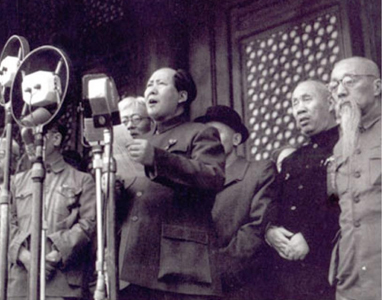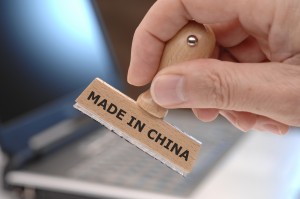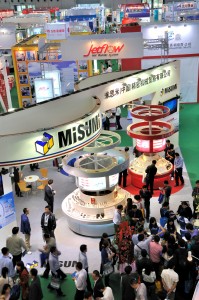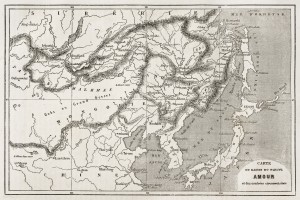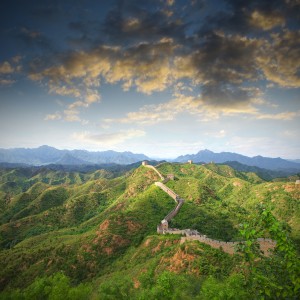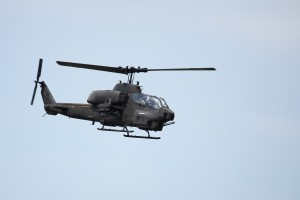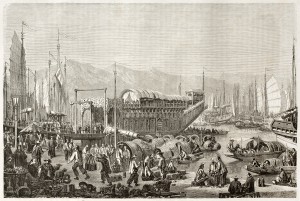China’s Military – Growing Assertiveness
Introduction
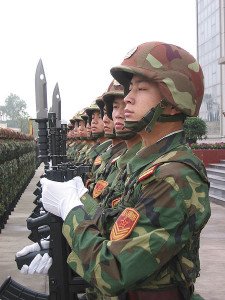
People’s Liberation Army
Over the last two decades, China has been steadily modernizing its military. This push to modernize reflects China’s desire to have military power commensurate with its growing economic and political status. It also reflects the fact that, from the Chinese perspective, the international realm gives rise to as many strategic uncertainties for China as a rising China does for other nations. In particular, many in China view the US as a strategic rival who wants to prevent China from becoming an equal leader on the global stage. The US’s “pivot to Asia” is viewed by many Chinese as example of the US’s containment effort. China is also unsettled by the US’s efforts to provide US allies and friendly states with weapons systems aimed to counter China’s growing military capability, and by the US’s continued arm sales to Taiwan.
Additionally, China considers Japan’s growing nationalism and Japan’s efforts to overhaul its military and security policies as a mounting threat. Its current alliances with North Korea and Russia notwithstanding, China views North Korea as a politically unstable nuclear power on its border, and Russia as a strategic competitor as well as an ally. China is also engaged in territorial disputes with Malaysia, the Philippines, Brunei, Vietnam, Taiwan and Japan in the South and East China Seas and with India on its western border. Additionally, China considers Taiwan, Tibet and Xinjiang to be its sovereign territory, and will fight their any move toward independence.
Other objectives of its military modernization program include improving China’s ability to fight piracy, to protect its shipping lanes and its access to energy and resources abroad, to help ensure the security of its international assets and to safeguard its growing numbers of citizens working and living overseas. From the Chinese perspective, protecting its economic trade and investments is critical to achieving Xi Jinping’s China dream – “achieving the great rejuvenation of the Chinese nation”. Indeed, China’s 2015 Military Strategy Document states: “the Dream is to make the country strong. Making the Chinese military strong is part of the Chinese Dream. Without a strong military, a country can be neither safe nor strong.” China sees the global trends toward “multi-polarity and economic globalization intensifying” which it believes will increase “international competition for the redistribution of power, rights and interests”. China sees a strong military as a competitive advantage as it vies for influence in this changing global landscape.
China continues to emphasize its military modernization is defensive in nature. China states that it will strike militarily only if it has been attacked first. Overall, China tries to play a long game when working to achieve its political, economic and military objectives. For example, while it will quell unrest in Xinjiang by force when necessary, ideally China hopes to overcome Uyghur opposition to Chinese rule through economic development and continued cultural integration. Similarly, before the International Tribunal of the Law of the Sea issues a ruling on Sino-Phillippines territorial disputes in the South China Sea – despite China refusing to participate in the arbitration – China is trying to maximize its facts in the water through the building of islands on contested reefs. By playing this long game in its strategic, multifaceted way, China is working to create a position of power so advantageous that it can accomplish its goals without ever having to use force. That said, China says that a first strike against the country need be military. China has stated that political, economic and strategic attacks could justify Chinese military action even if it means that People’s Liberation Army (PLA) fires the first weapon.
Levels of Military Spending
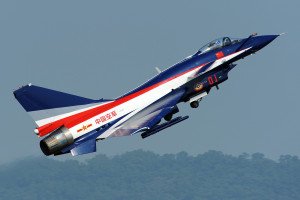
China’s J-10 airforce jet
According to the well-respected Stockholm International Peace Research Institute (SIPRI), China’s annual defense spending has grown from approximately $33 billion in 2000 to $130 billion in 2011 compared to the US’s $690 billion in 2011. As a percentage of total GDP, China’s annual military expenditure has remained fairly constant at 2.1% while the US has grown its military spending from 3% to 4.8% of GDP from 2000 to 2011. Applying these percentages to 2014 GDP figures, it is estimated that China spent approximately $217 billion on its military compared to the US’s $836 billion. At current trends, some project China to become the world’s largest military spender between 2025 and 2035.
In fact, SIPRI believes that China’s actual defense spending could be as much as 50% higher than Beijing states since China keeps many of its defense expenditures off book or accounts for them at below market costs. Indeed, according to Transparency International, China has one of the least transparent military budgets in the world. Items that may be omitted from its official defense numbers include military research and development, paramilitary expenses, weapons purchased from abroad, expenses for strategic and nuclear forces, subsidies given to state owned industries engaged in defense manufacturing, contributions from regional and local governments, spending on the military-relevant part of China’s space program and PLA-driven fund raising.
People’s Liberation Army (PLA)
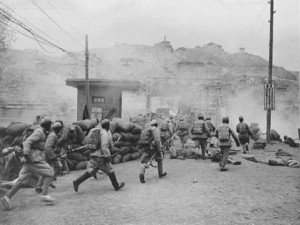
PLA fighting the Nationalists during the Chinese Civil War
The People’s Liberation Army (PLA) was officially founded on August 1st 1927, more than two decades before the establishment of the People’s Republic of China that it now defends. It was founded by the Chinese Communist Party (CCP) as they fought to win control of the country. The PLA is an umbrella organization overseeing the PLA’s Army (PLAA), the PLA Navy (PLAN), the PLA Air Force (PLAAF) and the PLA Second Artillery Force (PLASAF). The PLA is unorthodox in that does not actually answer to the State, but to the Chinese Communist Party itself. Thus, whereas the President of the United States is always Commander-in-Chief of the military, it is theoretically possible – although unlikely as long as the Communists remain in power – for the President of the PRC to not command the military. This makes the Head of the Central Military Commission (CMC) both important and powerful. Currently, Xi Jinping is both President of China and Head of the CMC and there has not been a discrepancy between the two posts since Jiang Zemin held onto the post of Head of the CMC for a year after handing the presidency over Hu Jintao. Chinese 2015 Military Strategy Document reaffirms the Chinese Communist Party’s absolute control of the military, “China’s armed forces will unswervingly adhere to the principle of the Communist Party of China’s absolute leadership” and “will work to build themselves into the People’s military that follows the CCP’s commands.”
Chinese Military Goals and Strategies
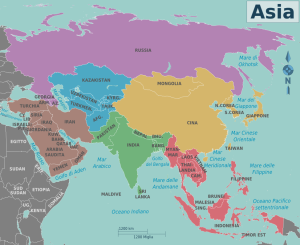
Map of China and its Neighbors
China believes that increased military power will give it the respect and power commensurate with its growing economic and political clout, will deter rivals from threatening its sovereign territory and national interests, and will allow it to influence international affairs in its favor. In the short term, China considers that its most immediate military threats are likely to occur along its periphery or in its near seas, and much of its recent military investment has been made with these threats in mind. Termed by China as “Local Wars under Conditions of Informatization” China sees any military conflict arising from these regional threats to be limited in scope and duration, and to be typified by the pursuit of political goals through relatively constrained use of rapid force. From a Chinese perspective, ideally these short conflicts will result in a quick return to the negotiating table with China in dominant position. In these “informatized” wars, China expects that the effective use of advanced computer systems, information technology and communication networks to provide China with key operational advantages.
Informatization for China has many facets. Of highest priority is its Computer Network Defense (CND) which it monitors vigilantly even in peacetime. In the event of war, China intends to quickly establish information operations (IO) dominance including controlling the electromagnetic spectrum which would allow it to suppress or deceive enemy electronic equipment. China’s electromagnetic warfare (EW) strategies focus on controlling radar, radio, optical, infrared, and microwave frequencies as well as disrupting adversarial computer and information systems. If necessary, China will use IO warfare preemptively, particularly when confronting information-dependent adversaries such as United States.
As part of this strategy, China foresees calling on millions of civilian Chinese programmers to work with the Chinese military to disrupt enemy technologies. The Chinese military also envisions that Chinese civilians will provide logistical and other support during war. This strategy of mobilizing all Chinese citizens in the case of conflict was reaffirmed in China’s 2015 Military Strategy Document “bring into full play the concept of the People’s war, and persist in employing it as an ace weapon to triumph over the enemy”.
China views improving its anti-access and area denial (A2/AD) capabilities as integral to its Local Wars strategy. A2/AD capabilities are intended to thwart third party intervention – particularly by the United States – into its territory or what it considers to be its spheres of influence which increasingly include the water and land within the South China, Yellow and East China Seas. These capabilities will also be key to preventing the US and other allies coming to Taiwan’s assistance if it moves toward independence.
Other military objectives include an improved ability to protect it economic shipping lanes and its rapidly growing number of citizens working abroad, to offer humanitarian assistance during times of natural and other disasters, and to project greater military authority in the Asia Pacific region and in regions further afield.
Cyberwarefare

Map of China and its Neighbors
Cyberwarfare is a major aspect of China’s informatization strategy. Since 2008, all major Chinese military exercises have had significant cyber information operations components which are both offensive and defensive in nature. Additionally, China runs an on-going cyber warfare program to steal intellectual property, trade secrets and technology from defense contractors, government agencies and research institutions valued at billions of dollars annually. The US government in particular has estimated that 90% of cyberespionage against the United States originates in China.
In 2013, the US computer security firm Mandiant noted that Chinese hackers breached US energy and other critical infrastructure, leaving in place software tools that could be activated to destroy infrastructure components. Mandiant also detailed methodical data theft from at least 141 US organizations over seven years; Mandiant tracked this theft back to a Chinese military unit code named 61398 which is staffed by a large cohort of proficient English speakers with advanced computer security and networking skills. Most of the Chinese targets were US companies operating in aerospace, satellites and telecommunications, public administration, information technology and scientific research fields or in industries identified as strategically important under its Five Year Plans. Unit 61398 also attacked a dozen smaller US local, state and federal government agencies as well as international governmental agencies. On average, the hackers operating within breached computer system for about a year stealing pricing documents, negotiation strategies, manufacturing processes, clinical trial results, technology blueprints and other proprietary information.
China is also the leading suspect in a June 5, 2015 hacking of the US Office of Personnel Management in which over 20 million employees, retirees, contractors and job applicants had their personal data compromised.
Space
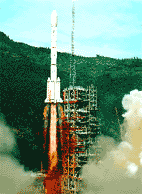
Launch of China’s Long March Rocket
China considers the ability to utilize space and to deny adversaries access to space as key to effectively implementing its Local Wars, A2/AD and other military strategies. To this effect, China is procuring a range of technologies to advance China’s space and counter space capabilities. China has developed and continues to develop imaging and remote sensing satellites with dual military and commercial missions, and currently has approximately 100 satellites in orbit. China controls satellites programmed in communications, navigation, Earth resources, weather, intelligence, surveillance and reconnaissance. Even the more commercially oriented satellites can assist the military by delivering situational awareness of foreign forces, critical infrastructure, and political targets. China also has demonstrated direct ascent kinetic kill anti-satellite capability to low Earth orbit. In 2007, for instance, China shot down a defunct weather satellite. Developing dual purpose satellites through commercial platforms has enabled China to access foreign technology through commercial means which it then uses to advance its military defense systems.
China believes that having high proficiency in counter space activities is critical to its being able to establish dominance in informatized warfare as satellites are significant to the communications, navigation and reconnaissance on modern day battlefields. By being able to take out enemy satellites, China aims to “blind and deafen its enemies” and to impede their ability to effectively use their precision guided weapons. As part of this effort, China is investing in a multidimensional program to advance its ability to limit or prevent the use of hostile space-based assets by developing jammers and directed energy weapons for direct ascent anti-satellite weapons used against China. Technologies advanced under China’s manned and lunar programs as well as technologies developed to detect and track space debris have significantly improved China’s ability to track and identify satellites, a prerequisite for ascent anti-satellite weapons attack. China is also continuing its development of the Long March 5 rocket, a next-generation heavy lift launch system designed to carry a load of up to 25,000 kg to low Earth orbits and 14,000 kg to geostationary transfer orbit. The first Long March 5 rocket is expected to be tested in 2016.
As part of China’s space effort, China is developing an independent human spaceflight program, and has a stated goal to construct a 60 ton space station. China’s growing space capabilities provide it with advanced skills which improve all aspects of conventional and nuclear targeting, ground air sea operations, precision conventional strike capacity and missile defense.
The PLA Army (PLAA) and the Arunachal Pradesh and Aksai Chin Disputes
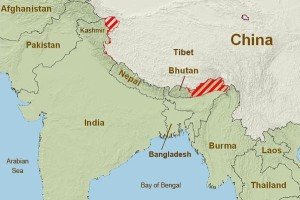
Map of Arunachal Pradesh and Aksai Chin
Owing to its 9000 mile temperate coastline with many good natural harbors, China is both a land and sea power. For millennia, however, China’s greatest military threat came from the land, particularly from the northern steppes with its fierce Mongol hordes. The large size of the PLAA compared to China’s other service branches reflects this historic land orientation. The PLAA has approximately 70% of total PLA servicemen under its command or 1.6 million ground force personnel, roughly 400,000 of whom are based in the three Chinese Military Regions opposite Taiwan. This personnel is organized into 18 Armies, with 15 infantry division and 16 brigades. The PLAA has an estimated 7000 and 8000 artillery pieces.
Since the 1980s, China has gradually decreased the size of its army while concurrently developing modern capabilities and systems. In particular, the PLAA is investing in heavy armor, long-range strike artillery, increased-range air defense weapons, and attack and transport helicopters. Its battle tanks, armored infantry fighting vehicles, armored personnel carriers, self-propelled artillery, and air defense weaponry have all enjoyed significant upgrades in the last decades. Today, for instance, approximately 45% of its armored infantry fighting vehicle and armored personnel carriers are modern, 31% of its main battle tanks are third-generation, and 15% of all the artillery is self-propelled compared with 0%, 0.1%, and 9% respectively in 2000.
The PLAA has focused on its armored fleet to improve its ability to move forces quickly within China and to its borders. In the Arunachal Pradesh and Aksai Chin areas, for instance, China is currently in dispute with India over ten separate territories at the Western End of the Tibetan Plateau, although several of the pieces of land are tiny. The two most significant areas of dispute are the 60,000 km² Arunachal Pradesh located in what India and most of the rest of the world consider to be the Indian state of Arunachal Pradesh, and the 37,000 km² Chinese administered Aksai Chin located to the west of Nepal, but claimed by India to be part of Kashmir. China and India have skirmished over these territories in 1962, 1967 and 1987. In 2009, China tried to prevent a $2.9 billion loan to India from the Asian Development Bank arguing that part of the funds would be employed to develop water projects in Arunachal Pradesh.
As well as aiding in border defense, improved military transport allows China to effectively quell domestic unrest particularly in Tibet and Xinjiang, and to have the army assist during natural disasters as it did in the aftermath of the 2008 Sichuan earthquake.
People’s Liberation Army’s Navy (PLAN)
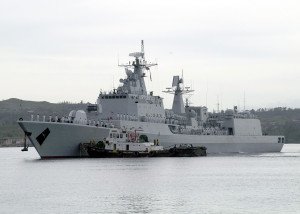
Chinese Naval Ship
Since 1990, PLAN has undergone significant modernization and expansion. As China reaffirmed in its 2015 Military Strategy Document, its “traditional mentality that land outweighs the sea must be abandoned, and great importance has to be placed on managing the seas and oceans and protecting maritime rights and interests.” Going forward, it can be expected that China will project hard power abroad primarily by means of its navy and its missile systems.
Today China has the largest naval force in Asia. In 2013, PLAN employed an estimated 255,000 sailors, soldiers, pilots and logistical personnel. Its fleet includes approximately 65 submarines, one aircraft carrier, 14 guided missile destroyers, 62 frigates, 211 patrol and coastal combatants, 238 amphibious boats and 205 logistics and support ships broken into three fleets: North, East and South fleets. PLAN also has an array of increasingly sophisticated aircraft from bombers and fighters to helicopters and transport aircraft. Over the next decades, China’s navy will continue to grow in both numbers and technological capability. Additionally, more of its fleet and fleet technology will be Chinese-built. For instance, the first Chinese-built aircraft carrier is slated to go to sea near 2020. Its current aircraft carrier, the Liaoning, is a refurbished vessel purchased from Ukraine in 1998.
Similarly, China is stepping up the production of its submarines, one of PLAN’s core strengths. Indeed, some predict that China’s submarine force could grow larger than that of the US within 15 years. As part of this submarine expansion program, China is upgrading missile systems and quieting technologies. It JIN-class sub, for instance, now carries ballistic missiles with an estimated range of more than 4000 nautical miles, giving China its first credible sea-based nuclear deterrent. Future submarines will have guided missile attack competence, giving China a submarine-based land-attack capability. Since 1990, China has brought to water six new classes of indigenously built destroyers and four new classes of frigates. These new ships have more up-to-date hull designs, propulsion systems, sensors, weapons and electronics.
China is also rapidly expanding its small combatants such as its JIANGDAO-class corvettes – the first six of which entered service in 2012; China is expected to build 20 to 30 corvettes in total. In 2004, China also introduced its Houbei-class wave-piercing, stealth catamaran missile patrol boats. Both these boats improve China’s operational ability in coastal and near waters. Being able to successfully engage in high intensity conflicts within the South China, East China and Yellow Seas remains China’s highest priority. As part of this effort, China is developing unmanned underwater vehicles and is continuing to upgrade its inventory of an estimated 50,000 naval mines.
Working in conjunction with PLAN, China operates other paramilitary maritime law enforcement agencies including the China Marine Surveillance, The Fisheries Law Enforcement, the China Coast Guard, the Maritime Safety Administration, and the Customs Anti-Smuggling Bureau.
People’s Liberation Army’s Naval Strategy and the Nine First and Second Island Chains
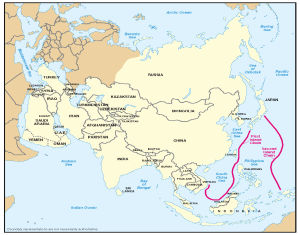
Map of First and Second Island Chains
In 1982, the architect of China’s modern naval strategy, Chinese Admiral Liu Huaqing, set as a goal for China to control the first island chain by 2010, the second island 2020, and for China to curtail US naval dominance in the Pacific and Indian Oceans between 2020 and 2040. An analysis of current Chinese military expansion, rhetoric and activities reveals that China is making strong efforts to implement this maritime strategy. Specifically, China is stepping up its efforts to exert control within the first island chain. The first island chain is defined as the chain of islands extending out from the East Asian continental mainland coast. In its broadest definition, the first island chain encompasses the Bering, Okhotsk, Japan, Yellow, East China and South China Seas including the Aleutian and Kuril Islands, parts of the Japanese Archipelago, the Ryukyu Islands, Taiwan, the northern Philippines and Borneo ending at the Malay Peninsula.
By demarcating the first and second island chains, PLAN hopes to engage foreign navies in waters as far as possible from China in order to defend its territory and its territorial waters. Other naval military goals include traditional missions such as protecting and evacuating Chinese nationals in foreign countries, providing humanitarian assistance and disaster relief, protecting sea trade from terrorism, maritime piracy and foreign interdiction, prohibiting foreign surveillance and reconnaissance activities near its coast and conducting independent and joint naval sea exercises. China is also using PLAN as a force to discourage Taiwan independence and to defend what it considers to be its land, fish, oil and gas rights in the East and South China Seas.
China also wants to regulate military activities in its exclusive economic zone (EEZ). An EEZ is the sea zone extending 200 nautical miles from a nation’s coast over which it has special rights regarding the exploration and use of marine resources. While the US and most other nations do not regard it as unlawful to be active in foreign EEZs, China maintains that it is unlawful for a foreign navy to penetrate China’s EEZ despite its activities to the contrary. Indeed on several occasions in 2001, 2002 and twice in 2009, Chinese aircraft confronted US Naval ships as they conducted ocean surveillance operations in the South China Sea. China is also creating coastal economic belts and marine economic zones within the first island chain area and is engaging in marine research and development.
The second island chain is a series of island groups that is generally defined to run north to south from the Kuril Islands, through the Japanese archipelago, the Bonin Islands, the Marianas Islands and Palou to the Indonesian archipelago. Over time, China hopes to extend its first island goals into this larger geographic sphere. China’s assertion into the second island chain is made difficult due to the strong presence of the US and its allies including Japan and South Korea who not only have their own significant military forces, but also provide air, naval, logistic and supply bases to the US Additionally, the US Navy dominates in the La Perouse, Tsugaru and Tsushima Straits, allowing it to move quickly to the Korean peninsula and to defend Guam, its main air and naval base in the Western Pacific.
To date, China’s sea experience beyond the second island chain has centered on its counter-piracy mission in the Gulf of Aden where it keeps an on-going, three ship naval presence to defend Chinese mercantile ships from pirate attacks. This is China’s first sustained naval operation outside of Asia. China has also begun to engage in some naval activities in the EEZs of other nations, particularly around Guam and Hawaii. China is also making long-distance deployments a more constant part of its naval training cycle. In 2012, for instance, it sent naval tasks groups beyond the first island chain seven times. Limited logistical support hampers China’s ability to operate its navy more widely. In the coming years, China will work with its allies to create welcoming logistical ports in the Indian Ocean and farther afield. An example would be its assistance in helping Pakistan to construct the deep water port Gwadar. China would also like to develop the capability to project power across the globe for sustained, high-intensity operations similar to those that the United Kingdom engaged in when retaking the Falkland Islands in early 1980. China would also like to displace US influence in littoral and more distant waters.
The Nine Dashed Line and China’s Territorial Disputes within the South China Sea
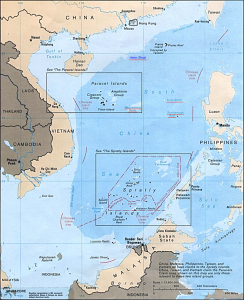
China’s Nine-Dashed Line
Within the first island chain, China has drawn the nine-dashed line by which it asserts that the majority of the South China Sea falls within its traditional maritime boundary line despite the boundary being more than a thousand miles from China’s mainland in several instances. Since November 2012, China has added a map with this line into all its passports in order to reinforce the validity of its nine-dashed claim, and makes increasing reference to the area in its government documents. Not only are islands, reefs and banks within the nine dashed line contested by many neighbouring countries, but there are also competing claims on the area’s fishing, oil and gas resources. Moreover, the South China Sea is a vital shipping lane for North East Asia. 80% of oil shipped to Japan, South Korea and Taiwan travels through South China Sea waters.
Within the East and South China Seas, China claims sovereignty to many islands also claimed by its neighbours. For instance, the Paracel Islands in the South China Sea are also claimed by Vietnam. The Spratly Islands, wholly claimed by China, are partly claimed by Malaysia, the Philippines, Brunei, and Vietnam, with Indonesia also claiming maritime rights in the area without actually staking a claim to any territory. Additionally, there are disputes with the over the Macclesfield Bank, and the Philippines and Taiwan over the Scarborough Shoal. The Macclesfield Bank, also known as the Zhongsha Qundao, is a completely submerged chain of reefs that does not qualify as territory under international law since it cannot be inhabited by human beings. The Scarborough Shoal, known in Chinese as the Nanyan Dao, is a group of small islets or rocks and thus subject to international jurisdiction. One motivation for China to claim these islands is that it will allow it to expand its EEZ throughout the area.
Disputed Territory in the East China Sea within the First Island Chain
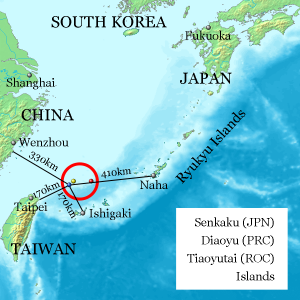
Map of the Senkaku and Diaoyu Islands
In the East China Sea, the Diaoyu/Senkaku Islands are also claimed by Japan and Taiwan. At stake in these contested areas vast amounts of natural gas and oil beneath the sea beds as well as rich fishing resources. The East China Sea alone, for instance, is believed to hold approximately 7 trillion ft.³ of natural gas and up to 100 billion barrels of oil. Japan has suggested that the East China Sea be divided into separate EEZ with a line equidistant from each country allowing each to share the offshore oil and gas deposits. Instead, China claims an extended continental shelf reaching almost to Okinawa, giving it effectively exclusive rights to almost all the East China Sea oil and gas. In an effort to create a precedent for its claim and in part to intimidate, China has increased its naval, paramilitary and its joint naval/air force training activities in the sea/air area surrounding Japan.
PLA Air Force (PLAAF)
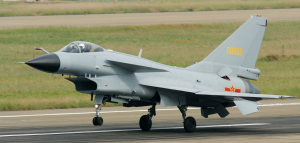
Chinese Airforce Jet
The PLAAF is in control of China’s territorial air security. It currently commands 398,000 officers and men divided between its seven military area commands in Shenyang, Beijing, Lanzhou, Jinan, Nanjing, Guangzhou and Chengdu. The PLAAF is composed of aviation, ground air defense, radar, airborne and electronic countermeasures arms. As of 2013, it commands approximately 1700 Fighters, 600 Bombers/Attack and 475 transport aircraft. While China increasingly flies modern fourth-generation and early fifth generation aircraft, about 68% of Chinese air fleet are still second and third generation aircraft or upgraded models of these aircraft.
That said, in 2013 China was considered to have over 500 modern fourth generation aircraft, outnumbering most air forces in the Asia-Pacific region. China’s fourth-generation fighters include the J-10, J-11, Su-27, Su-30, JH-7, J-15, J-20 and J-31 aircraft. China is also developing its fifth generation fighter force, slated to take flight around 2020. These new fighters will have significant maneuverability, stealth, internal weapons bays, modern avionics and sensors that offer better situational awareness for network-centric combat theaters, radars with high-level targeting capabilities and protection against electronic countermeasures, and integrated electronic warfare systems with advanced communication and GPS navigation functions.
As it modernizes, the PLAAF is emphasizing the development of new generation aircraft which will be effective in its Local Wars strategy and which can support the other PLA branches along the entire periphery of China and increasingly in the East, Yellow and South China Seas. China is also upgrading it H-6 bomber fleet to achieve greater range and to be armed with long-range cruise missiles. China is also developing a large aircraft likely to be called the Y-20 which will work in conjunction with its smaller fleet of strategic airlift aircraft.
China’s commercial and military aviation industries work together to advance China’s overall aeronautics standards, and share technology and systems. China’s military aviation has benefited from business partnerships with Western aviation and aerospace firms where technology shared for commercial purposes has then been employed to improve China’s military aircraft.
China is also building a state-of-the-art national integrated air defense system. The air defense system is multidimensional, employing weapon systems, radar and C4ISR- Command, Control, Communications, Computers, Intelligence, Surveillance and Reconnaissance – platforms to counter multiple types of aircraft at various ranges and altitudes. A further goal of the air defense system is to protect China from precision strike ballistic and cruise missiles, particularly those fired from long distances. China is also upgrading its early warning, command and communication networks, and it is improving its long distance airstrike capabilities.
Drones
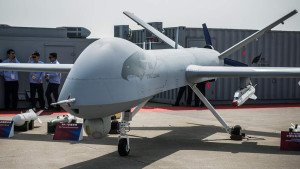
Chinese Drone
China is also developing unmanned aerial vehicles or drones which currently seem to be largely founded upon reverse engineering of foreign technologies. Research indicates that China plans to build as many as 40,000 land- and sea-based unmanned systems between 2014 in 2023. By way of comparison, the Pentagon only operates approximately 7000 aerial drones. In 2013 alone, the Chinese unveiled four drone models – the Xianglong, Yilong, Sky Saber, and Lijian. The Pentagon believes that the Yilong, Sky Saber, and Lijian are all precision-strike weapons, and the Lijian drone has some stealth capability. To date, most of China’s drone fleet has been employed in surveillance of China’s domestic population. For instance, China has been flying drones in Xinjiang in order to counter unrest in the province.
In June 2015, China released pictures of its new Divine Eagle, one of the world’s largest twin fuselage drones. Influenced by the Russian designs – there’s speculation that China stole critical design features from Russia – the Divine Eagle is a high-altitude, long-endurance multi-mission platform with both long-range surveillance as well as strike capabilities with some stealth capability. It is reported to carry multiple Active Electronically Scanned Array radars as well as Airborne Moving Target Indicators that are designed to track airborne targets such as enemy fighters and cruise missiles. This large drone platform is ultimately expected to act as an effective satellites to aid in the targeting of missiles and other tactical platforms well beyond the first island chain. When fully operational, it will be harder for the United States and its allies to operate undetected close to Chinese shores.
China has also been progressing its ability to electronically jam US drone flights, especially those flying over the South and East China Seas which are conducting surveillance on China’s island construction and other activities in disputed waters and territories.
PLA Missile Forces – the Second Artillery Force (PLASAF)

Map of range of Chinese Missiles
China’s Second Artillery Force (PLASAF) controls China’s nuclear and conventional ballistic missiles. The PLASAF runs missile bases, training bases, specialized support units, academic and research institutions. It has approximately 100,000 men under its command. China has one of the largest, most diverse and rapidly growing missile development programs in the world. It is currently estimated that the PLASAF has command over approximately 1000-2000 short-range ballistic missiles, 50-75 intercontinental ballistic missiles, 75-100 medium range ballistic missiles, 5-20 intermediate range ballistic missiles, 200-500 ground launched cruise missiles. In 2015, it was also confirmed that China now has nuclear missile technology with multiple independently-targetable re-entry vehicles (MIRV) – or the capability to place multiple warheads on a single missile and deliver the individual warheads to separate targets.
The development of China’s missile force has been impressively quick. Even just ten years back, China had a very limited ability to attack targets within or beyond the first island chain. China has modernized its missile force under a strategy of dual deterrence and dual operations. The basic idea behind dual deterrence and dual operations is that both conventional and nuclear missile capabilities will most effectively deter China’s adversaries from starting a war and defend China during wartime. Today, the SAF has the ability to credibly deter adversaries at intercontinental ranges; its DF-3, B-6 and LACM missiles, for instance, can strike targets 3300 km away. It has been a priority for China to extend its strike warfare further from its borders. Other objectives of the PLASAF program include effecting A2/AD operations, and deterring any move by Taiwan toward independence. Indeed, China has an estimated 1100 short range ballistic missiles currently targeted at Taiwan.
China is also developing a missile defense system involving the use of kinetic energy intercept at exo-atmospheric altitudes as well as intercepts of ballistic missiles and other aerospace vehicles within the upper atmosphere. China has already demonstrated an ability to intercept ballistic missiles at midcourse using ground-based missiles. To protect its missile systems, China has developed a 5000 km long network to mitigate the risk that its missile network could be materially weakened by a preemptive strike. For each missile launcher, China also has a large inventory of reserve missiles to ensure its ability to engage in sustained conflict if China were to come under attack.
Nuclear Weapons

An early Chinese nuclear bomb
China launched its nuclear weapons program in 1955 and detonated its first nuclear bomb in 1964. China is in a unique geo-strategic situation in that it shares land borders with four nuclear powers – Russia, North Korea, India and Pakistan – and faces the consideration that of the other four nuclear powers, three – the US, France and the UK – all have the ability to reach China with their nuclear weapons. China therefore believes that the maintenance of a nuclear arsenal is of existential importance. It also believes that its risk of being attacked by nuclear weapons declines significantly if an adversary’s initial nuclear strike does not eliminate China’s ability to retaliate. China therefore values secrecy over transparency in regards to its nuclear program.
It is estimated that China has approximately 130-195 deployed nuclear-capable weapons ready to be deployed on a variety of short- and long-range ballistic land- and sub-based missiles systems, although some US experts believe that China is hiding a much larger nuclear arsenal. Improving the range and numbers of its submarine-launched nuclear arsenal is a priority. In total, China’s has a nuclear inventory of approximately 250- 300 nuclear weapons. Additionally, it is also believed that China has a stockpile of about 16 tons of highly enriched uranium and 2 tons of plutonium. China also operates reprocessing spent plutonium fuel plants. These facilities isolate plutonium that is created from the reactor from spent fuel. China also runs an experimental fast breeder reactor and has been is considering purchasing two further fast reactors from Russia. If so compelled, China may be able to use plutonium created in these facilities for military use.
China has conducted 45 nuclear tests. In the 1990s, China accelerated the pace of its nuclear testing in order to complete a series of tests on smaller warhead designs before becoming a signatory of the 1996 Comprehensive Nuclear Test Ban Treaty created to prevent all nuclear explosions in all environments for both military and civilian purposes. China is also a signatory to the 1970 Treaty on the Non-Proliferation of Nuclear Weapons designed to stop the spread of nuclear weapons and weapons technology. In 2002, China ratified the International Atomic Energy Agency’s (IAEA) Additional Protocol IAEA which allows the IAEA to conduct extended inspections of nuclear facilities to verify records maintained by State authorities on the whereabouts of nuclear material under their control, to check IAEA-installed instruments and surveillance equipment, and to confirm physical inventories of nuclear material. China also has a “no first use” policy and a policy to not use nuclear weapons against non-nuclear states.
China’s Reserve Forces, Militia and Paramilitary Forces
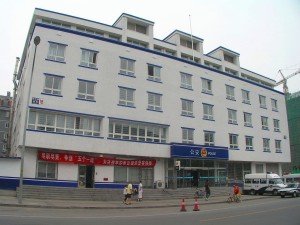
Ministry of State Security
In addition to the PLA’s armed forces, China also has approximately 510,000 military Reserve Forces, and an estimated 8 million Militia Members. Reserve officers are recruited from China’s pools of retired servicemen, civil officials, cadre of the people’s armed forces department, cadre of militia and civilian technicians. The Reserve Forces are designed to buttress regular PLA units during times of conflict in areas such as logistics and information warfare. The PLA Militia Forces are under the command of local military district governments, and are dedicated to logistics and technical support, air defense, internal security and stability, counterterrorism, disaster relief and emergency rescue. Each year, approximately 90,000 militia guard the country’s bridges, tunnels and railway, 200,000 join in military-police-civilian defense patrols, 900,000 in emergency response, rescue and relief operation following major natural disasters, and nearly 2,000,000 help to maintain social order in rural and urban areas. Increasingly the militia is being organized into specialized technical units including anti-aircraft artillery, ground artillery, missile, communication, engineering, anti-chemical, reconnaissance and information units. Other units are being developed to serve separately the Navy, Air Force and Second Artillery Force. The Militia is trained to help during natural and other emergencies and to maintain domestic stability. Most Militia hold regular jobs as well as being Militia members.
China’s other security and paramilitary forces include the Ministry of State Security which engages in foreign and domestic intelligence and counter-intelligence collection, and the Ministry of Public Security which is responsible for internal security and oversees the 1.9 million police personnel which in turn provide domestic patrol, traffic control, detective investigations, anti-riot and anti-terrorism services. China’s 660,000 strong People’s Armed Police Force acts as an internal security force, operates as a rapid response force for public emergencies, guards critical infrastructure and resources including gold mines, hydroelectric projects and transportation facilities, combats terrorism and supports national economic development. The People’s Armed Police Force is divided between the Internal Security Forces and the Border Defense Force including the Coast Guard, the China Marine Survey Agency, the Maritime Safety Administration and Fisheries Enforcement.
Upgrading all PLA force
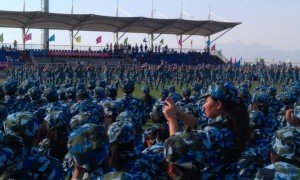
Training Chinese troops
As it reduces the overall troop numbers, China is increasingly recruiting personnel with higher levels of education. The PLA gives bonuses of up to $3500 to college graduates who volunteer for the Armed Forces and tuition allowances to college student deferring university education for PLA service. In 2009, for instance, the PLA recruited 100,000 college graduates. The PLA also grants civilians with particular technical skills NCO rank when they join up. It also supports veterans seeking advanced degrees and provides them with advanced employment opportunities and exemptions from postgraduate entrance exams. China’s 2015 Military Strategy Document China is also placing more emphasis on training it forces in military theory- “to bring it into place a system of advanced military theory commensurate with the requirements of future wars.”
As part of its training, the 2015 Military Strategy Document reaffirms that all forces in the PLA “always treat ideological and political building as the first priority” so that the PLA will carry forward “the Core Socialist Values, cultivate the Core Values of Contemporary Revolutionary Service Personnel” and will uphold “the Communist Party of China absolute leadership over the military” and “the Armed Forces will resolutely follow the commands of the CPC Central committee at all times and under all conditions.”
Military Alliances and Cooperation
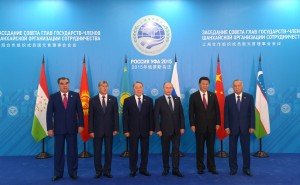
Summit of the Shanghai Cooperation Organization
China’s 2015 Military Strategy Document states that it is China’s objective to “actively expanded military and security cooperation, deepen its military relations with major powers, neighboring countries and other developing countries, and promote the establishment of the regional framework for security and cooperation.” China participates in a myriad of military alliances, multilateral dialogue and cooperation mechanism such as the Shanghai Cooperation Organization (SCO), ASEAN Defense Ministers Meeting plus, ASEAN Regional Forum, Shangri-La Dialogue, Jakarta International Defense Dialogue, in the Western Pacific Naval Symposium.
Arguably China’s most important current military relationship is with Russia. The US rebalance to Asia and Russia’s involvement in Crimea and Ukraine – sanctioned by the West -have led to an improved relationship between China and Russia. President Xi Jinping’s made his first official state visit to Moscow in 2013 while Putin made his first foreign trip to China after re-assuming the Russian presidency in 2012. Concurrently, the two countries signed agreements on cooperation in military exchanges, technology, energy and trade. China and Russia also ratified the 2013-2016 implementation guidelines of the China-Russia Treaty of Good Neighborliness and Friendly Cooperation. Additionally, in July 2013, Russia and China’s Navies staged their largest ever joint naval drill, the Joint Sea – 2013 exercises, and the two countries are also conducting anti-terrorism drills together. Bilateral trade between the two countries is expected to reach $100 billion by 2015 and $200 billion by 2020, driven in part by a 2013 $270 billion deal in which Russia will double its oil exports to China.
China is a member of the Shanghai Cooperation Organization (SCO) comprised of China, Russia, Kazakhstan, Uzbekistan, Tajikistan, and Kyrgyzstan. The key objective of the SCO is enhanced regional security focused on combating the “three evils” of terrorism, extremism and separatism; in the case of separatism, the SCO cooperates to ensure that “color revolutions” do not threaten the stability of the region. Annual joint practice operations in various fields of conflict have increased to include a total of more than 5000 participants from all six member states. The majority of these participants come from the China and Russia; closer military and strategic ties between these two states is one of the most significant outcomes of the SCO’s development. In 2015, for instance, China and Russia conducted joint naval exercises in the Mediterranean.
The promotion of closer economic ties is also an objective of the SCO. China has proposed, for instance, that the Russian led Eurasian Economic Union (EEU) – a trading blocking comprised of Armenia, Belarus, Kazakhstan and Russia – connect with China’s rapidly developing Silk Road Economic Belt – a series of economic initiatives that follow the Old Silk Roads across Eurasia and South Asia. China sees closer economic ties including everything from the increased trade of oil to the expansion of transportation, infrastructure and cultural ties across the region.
Importantly, the SCO is expanding its members to include two of its three observers – India and Pakistan; the third observer Iran is not currently eligible due to international sanctions, although this may change if the Iranian nuclear deal is ratified. Pakistan believes membership in the SCO will provide it with enhanced tools to combat extremism within its borders, will enhance its international prestige, will potentially help improve its relations with India and may help it resolve its dispute with India over Kashmir. India sees the SCO as a mechanism to improve its relations with Pakistan as well as Russia, China and the countries in Central Asia. From China’s perspective, expanding SCO membership increases the prestige of an organization in which it has a leading position.
Since 2001, when China first became involved in UN backed peacekeeping operations (PKOs), it has rapidly increased its level of commitment. At the beginning of 2012, China had more than 1800 troops involved in PKOs, slightly down from a high of 2100 in 2008, but still more than any other permanent member of the UN Security Council. In 2014, China had over 3000 Chinese soldiers serving with the UN.
Future Trends
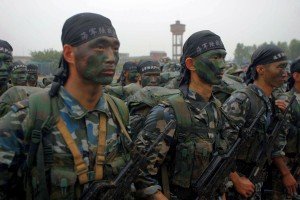
Chinese soldiers
China’s 2015 Military Strategy Document sees the world becoming increasingly multi-polar and globally interconnected with “historic changes in the balance of power, global governance structure, Asia-Pacific geostrategic landscape.” It sees increased international competition “in the economic, scientific and technological and military fields” and “for the redistribution of power, rights and interests”. Against this changing landscape, it is China’s goal to achieve “the great rejuvenation of the Chinese nation … by 2049 when the People’s Republic of China marks its centenary”. China sees its military buildup as key to allowing China to benefit from this shifting landscape and as key to reclaiming its positioning as a global world leader.
Given this, it can be expected that China’s military build-up will continue apace. Indeed, it is China’s goal to develop a world-class military in all branches over the coming decades. Thus, as its economic growth rate natural slows from historic blistering rates, it is possible that China’s military spending as a percentage of GDP may increase above its 2% level.
In terms of emphasis, China will continue to prioritize space and other technologies that will give it an edge in “informatized” warfare; China views technology as key to offsetting its deficits in military strength and experience. Continued naval and missile build-up will be prioritize; it sees these arms as being particularly critical to diminishing US military hegemony. Specifically, its paramilitary naval forces are expected to increase by 25% over the next decade; China sees its paramilitary as a way to assert its near seas claims in way that is less confrontational than if the same actions were taken by its navy. China will also prioritize the development of air force and drone stealth technology as part of its A2/AD strategy. China will also invest heavily in underground facilities to safeguard all branches of its military.
Such upgrades on technology will continue to reduce the need for raw manpower – in line with most modern militaries around the world. To this end, Xi Jinping announced a further reduction in troop numbers of 300,000 during his speech in China’s large military parade on September 3rd 2015. Though significant, this will still leave the PLA as the largest military force in the world.
China will continue to use non-military tools to achieve its objectives. These include everything from increasing its international media presence to pushing ahead with its build-up of land masses on atolls in the South China Sea to continuing its massive lending, investment and aid programs.
Going forward, China will also place increased emphasis on the quality of its military training with more emphasis being placed on training in difficult weather, terrain and electromagnetic conditions. China will also continue to improve troop skills with its new technologies and weaponry. China will also engage in more joint training between its military branches. Prior to 2000, joint training across branches was very infrequent. China will also continue to participate in joint training organizations with its allies.
Overtime, China will also increasingly develop its own indigenous military equipment and weapons systems so that it can limit its dependence on foreign weapons systems, particularly those of Russia. It will also work to expand its global port and base access so that it can project its forces farther from its shores.
As China develops indigenous weapons, it can be expected that its military exports will continue to grow. From 2009 to 2013, Chinese arms exports totaled approximately $14 billion. To date, these weapons have been less sophisticated than Western and Russian exports. Pakistan is China’s largest arms customer; the two countries also co-develop weapons system such as the JF-17 fighter aircraft and the F-22P frigate. China uses its weapons sales as part of a multi-pronged strategy to promote trade, access natural resources and expand its global influence. From its customers point of view, Chinese arms come with fewer political strings attached which appeals to those who might otherwise have little access to Western weaponry.
China can also be expected to more aggressively assert its claims over contested territory and resources in its near seas, actions which come in conflict with its assertion of a peaceful rise. Interfering with resupply missions to the Philippine outpost on the Thomas Shoal and the deployment of oil rigs to what Vietnam considers its EEZ are recent examples of this greater assertion.

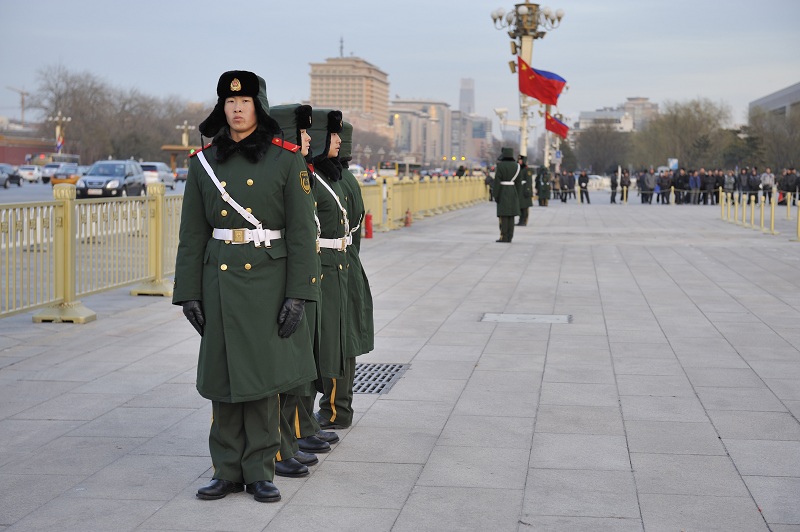
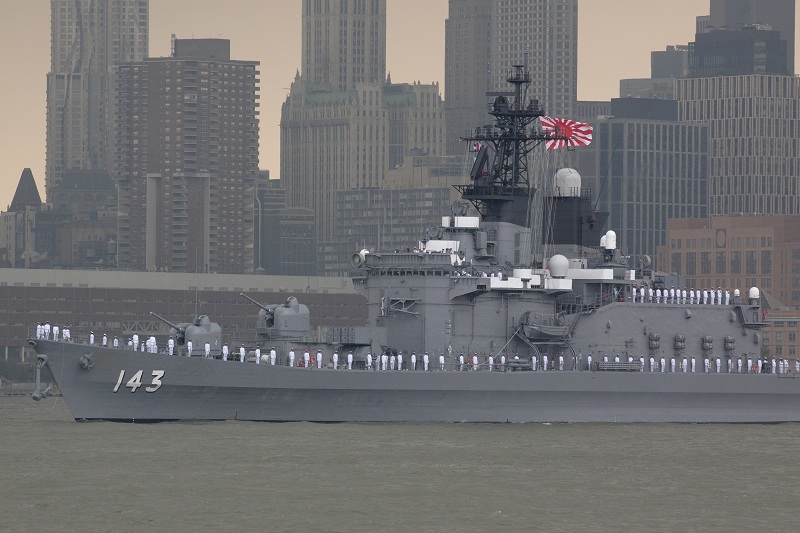
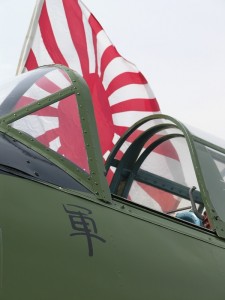
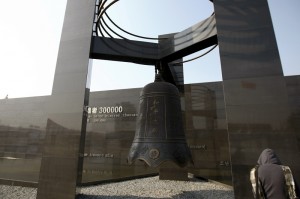
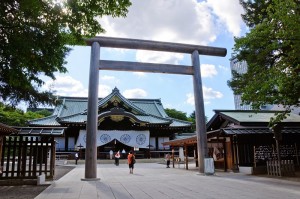
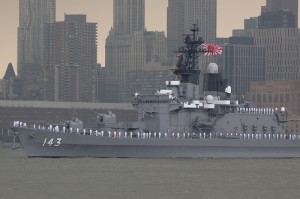

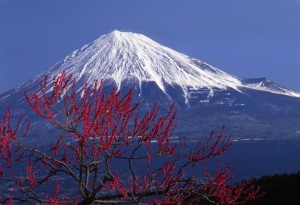
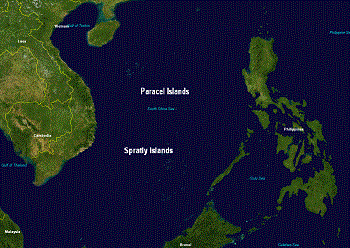
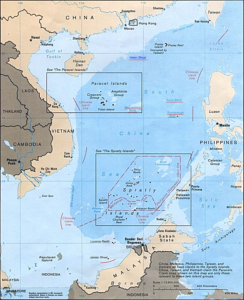
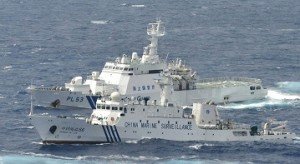
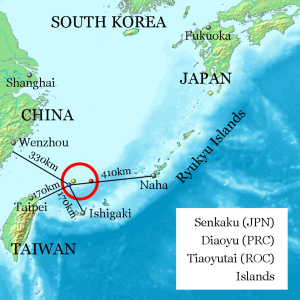
![By Wuyouyuan (Own work) [CC-BY-SA-3.0 (http://creativecommons.org/licenses/by-sa/3.0)], via Wikimedia Commons](https://chinafolio.com/wp-content/uploads/2013/03/Diaoyu_dao_quanjing_poster_IMG_1456A.jpg)
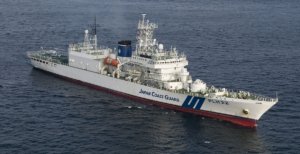
![By 中国海监总队/China Marine Surveillance (中国海监总队/China Marine Surveillance) [Public domain], via Wikimedia Commons](https://chinafolio.com/wp-content/uploads/2013/03/2012_China_anti-Japanese_demonstrations_in_Beijing-300x162.jpg)
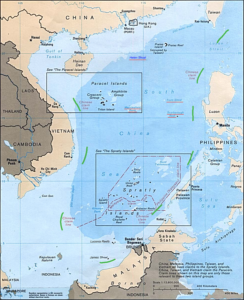
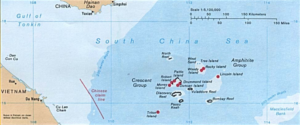
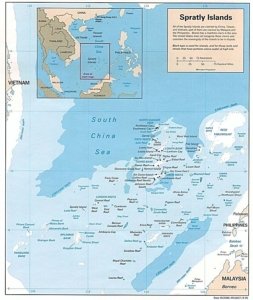

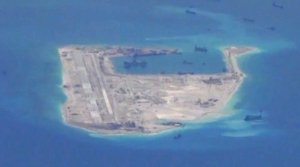 In 2014, China initiated dredging operations to build artificial islands around seven reefs near the Spratly Islands despite competing claims by Taiwan, Vietnam, the Philippines, and Malaysia. China is also building and fortifying an island on the strategic Scarborough Shoal, located 140 miles west of the large Philippine island of Luzon, and on Woody Island in the Paracels, located close to the Vietnam shore. By mid-2015, China’s land reclamation project had constructed almost 2000 acres of new land. On one artificial island built on Fiery Cross Reef near the Spratly Islands, China has built military barracks, weapon delivery systems, radar installations, jamming technology, lookout towers, and runways that have been used for the deployment of Chinese fighter jets. This military buildup is allowing China to significantly strengthen China’s anti-access/area-denial capacity and to increase its projection of force throughout the region. This projection includes an increase in the deployment of surveillance aircraft and guided-missile destroyer patrols as well as the actuation of radar, satellite, and other military surveillance equipment. These efforts have markedly increased China’s military presence in the South China Sea and significantly upgraded its peace and wartime positions. These islands are also creating facts on the ground which enable China to strengthen its de facto control over the water and the territory within its nine-dash line.
In 2014, China initiated dredging operations to build artificial islands around seven reefs near the Spratly Islands despite competing claims by Taiwan, Vietnam, the Philippines, and Malaysia. China is also building and fortifying an island on the strategic Scarborough Shoal, located 140 miles west of the large Philippine island of Luzon, and on Woody Island in the Paracels, located close to the Vietnam shore. By mid-2015, China’s land reclamation project had constructed almost 2000 acres of new land. On one artificial island built on Fiery Cross Reef near the Spratly Islands, China has built military barracks, weapon delivery systems, radar installations, jamming technology, lookout towers, and runways that have been used for the deployment of Chinese fighter jets. This military buildup is allowing China to significantly strengthen China’s anti-access/area-denial capacity and to increase its projection of force throughout the region. This projection includes an increase in the deployment of surveillance aircraft and guided-missile destroyer patrols as well as the actuation of radar, satellite, and other military surveillance equipment. These efforts have markedly increased China’s military presence in the South China Sea and significantly upgraded its peace and wartime positions. These islands are also creating facts on the ground which enable China to strengthen its de facto control over the water and the territory within its nine-dash line.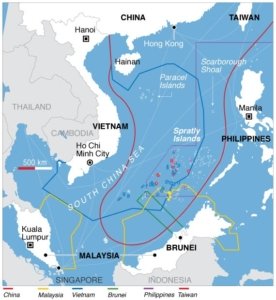 In 2013, the Philippines commenced an arbitral proceeding against China under articles 286 and 287 of United Nations Convention of the Law of the Sea. In its claims against China, the Philippines declared: that China’s nine dash line was invalid; that certain maritime features were claimed by both China and the Philippines; that China was unlawfully utilizing the living and nonliving resources in the Philippines’ exclusive economic zone and in the Philippines’ continental shelf; that the Philippines was being prohibited from reaping the benefits of said resources; that China had broken its responsibilities to protect and conserve the marine environment through its gathering of endangered marine species and coral as well as through the erection of artificial land features; and finally that China was unsafely maneuvering government vessels in a manner that was marring the navigation of Philippine vessels.
In 2013, the Philippines commenced an arbitral proceeding against China under articles 286 and 287 of United Nations Convention of the Law of the Sea. In its claims against China, the Philippines declared: that China’s nine dash line was invalid; that certain maritime features were claimed by both China and the Philippines; that China was unlawfully utilizing the living and nonliving resources in the Philippines’ exclusive economic zone and in the Philippines’ continental shelf; that the Philippines was being prohibited from reaping the benefits of said resources; that China had broken its responsibilities to protect and conserve the marine environment through its gathering of endangered marine species and coral as well as through the erection of artificial land features; and finally that China was unsafely maneuvering government vessels in a manner that was marring the navigation of Philippine vessels.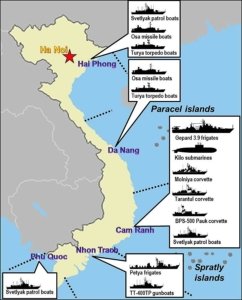 Secondly, many of China’s neighbors in the region are seeking individually and together to balance against China’s rise. This is evidenced first by the fact that defense spending in Asia is growing more rapidly than in any other region in the world. Specifically, it is estimated that between 2016 and 2020, the littoral states of South China Sea are expected to increase defense spending by 50%. There is also been an increase in joint military cooperation between many of the East and Southeast Asian countries including Japan, South Korea, Australia, India, and Vietnam, and with East and Southeast Asian countries and the United States. This growing Asian military spending and this increase in inter-Asian alliances reflects a recognition of a decreasing ability and willingness on the part of the United States to project its power within Asia.
Secondly, many of China’s neighbors in the region are seeking individually and together to balance against China’s rise. This is evidenced first by the fact that defense spending in Asia is growing more rapidly than in any other region in the world. Specifically, it is estimated that between 2016 and 2020, the littoral states of South China Sea are expected to increase defense spending by 50%. There is also been an increase in joint military cooperation between many of the East and Southeast Asian countries including Japan, South Korea, Australia, India, and Vietnam, and with East and Southeast Asian countries and the United States. This growing Asian military spending and this increase in inter-Asian alliances reflects a recognition of a decreasing ability and willingness on the part of the United States to project its power within Asia.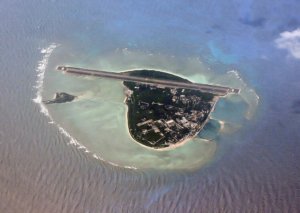 Finally, despite the costs to China’s international position and various bilateral relationships, its strategic and military position has been unquestionably strengthened in various parts of the South and East China Seas. It now controls, or has access to, several strategic positions that previously it did not. From a purely traditional military point of view, this can be viewed as a significant success and a gain in the balance of power in the region. China can be expected to consolidate these gains over the coming decade, all the while working to not antagonize the US or its Asian allies to the point of confrontation as it tightens its hold on the region. That said, China’s more aggressive stance increases the chance that confrontation could result from misstep or from misunderstanding.
Finally, despite the costs to China’s international position and various bilateral relationships, its strategic and military position has been unquestionably strengthened in various parts of the South and East China Seas. It now controls, or has access to, several strategic positions that previously it did not. From a purely traditional military point of view, this can be viewed as a significant success and a gain in the balance of power in the region. China can be expected to consolidate these gains over the coming decade, all the while working to not antagonize the US or its Asian allies to the point of confrontation as it tightens its hold on the region. That said, China’s more aggressive stance increases the chance that confrontation could result from misstep or from misunderstanding.